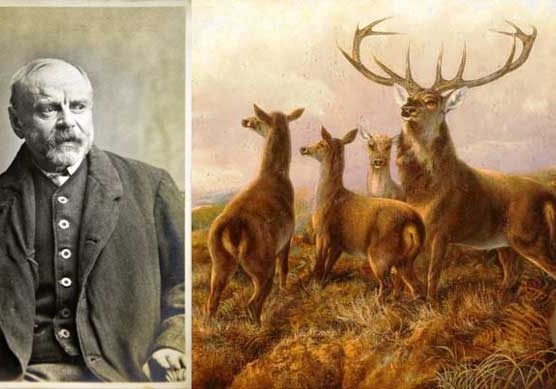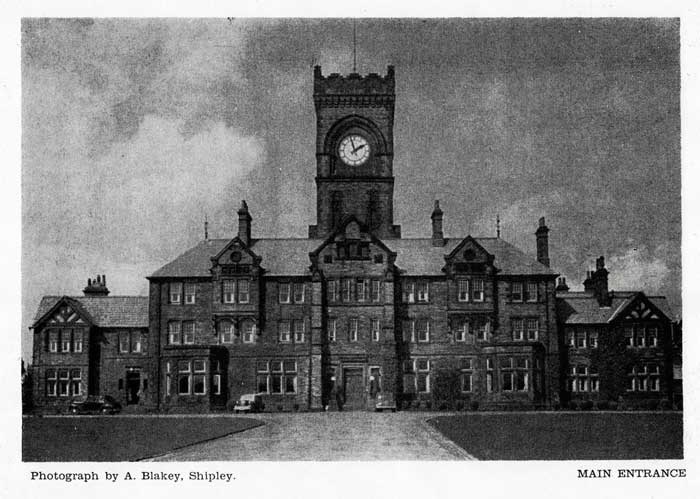
The rise and fall of Clarence Roe
by Mark Davis
Clarence Roe had the potential to be one of the greatest British painters of the Victorian era… but he ended his life in a Yorkshire asylum as an alcoholic suffering from delusions and hallucinations.
It was a sad end for a man brought up in West Yorkshire, who had shown so much artistic promise and lived a life full of incident, including arrests for drunkenness, theft and train-fare dodging, prison at Leeds, and divorce by a wife who accused him of deliberately infecting her with venereal disease.
Roe spent his final weeks in Menston Asylum near Wakefield.
Admitted on September 7, 1909, as patient number 8502, Roe was assessed to be suffering from “grandiose delusions e.g. says he has 5,000 shares in the Midland Railway Co and 2,000 preference shares, says he has a 200 horsepower motor, has a large estate near Sheffield. All of the above are delusion. Is very talkative and excitable. Says he was brought here without a trial.
“This patient was sent here from prison, having been sentenced for travelling abroad without a ticket. He says he has been wrongfully committed as he was entitled to travel without a ticket being a director and large shareholder of the Midland Railway Co.
“He says he possesses large sums of money. He has some hallucinations of sight. These delusions are of identity. He enters readily into conversation, repeats intelligently on various subjects, but his attention is inclined to wander occasionally. He becomes slightly incoherent at times. His memory is excellent. He is able to relate clearly happenings of thirty or forty years ago. He is restless, uneasy and sleeps badly and wet in his habits.”

The marker on Clarence Roe’s grave in what is now the a memorial garden
This word picture of a broken man is a far cry from Clarence Roe’s early life, brought up in an artistic family.
Some sources state that Roe was born in either Cumbria or Glasgow, but according to art researcher Marie Riley, who has exchanged information with me, he was actually born in Birmingham, the eldest son of Robert Henry Roe and Emma Baily.
Robert Henry Roe was closely was intimately acquainted with great artists such as Turner, the Landseers, Herring and Copley, and Emma was a daughter of E H Baily, sculptor of the figure of Nelson on the Trafalgar Square column.
The Roe family lived in Hampstead but then lived in Scotland during the mid to late 1850s and by 1860 they settled in West Yorkshire when Clarence was 10 years old. Artistic talent ran in the family and Clarence’s three brothers and one of his sisters were all artists of repute.
Clarence was a prolific artist, turning out landscapes, often featuring the Scottish highlands, on a near-industrial scale. One dealer had known him paint two 36-inch by 24-inch canvases in one day. He usually got £30 or £40 each for his paintings, and at the time was making a thousand pounds a year, a considerable sum in the later 19th century.
Clarence led a colourful life. According to researcher Marie Riley, Clarence was married at age 20 to 16-yearold Almira Sherborne, daughter of Bristol artist Henry Sherborne, and she is thought to have died between 1871 and 1875 when he remarried.

Startled Deer in a Landscape, one of Roe’s many fine highland paintings, which is in Lytham St Annes Art Collection
His second wife, Rosa Adelaide Hulme, divorced him four years later. In her petition filed on October 29th, 1878, she cited not only his desertion and adultery with a number of women, but also of him having ‘wilfully and recklessly’ infected her with venereal disease.’ The divorce was granted in November 1879. He married a third time in 1881 to Ellen Fenely Fletcher.
Alcohol seems to have played a large part in Roe’s downfall. In 1883 he was fined five shillings for drunkenness in a public house in Sheffield. Three years later he was declared bankrupt in Kendal, Westmorland.
In 1890, he was found guilty of stealing a leather bag and articles of clothing from Leeds railway station. He had alighted from the train from Harrogate and the items belonged to another passenger. His defence lawyer argued that Roe had a similar bag and was too drunk to realise that it wasn’t his property.
The judge said that he had known the prisoner’s name and that of his artists’ family in the West Riding of Yorkshire for many years and it was painful for him to have to pass sentence. He believed that Roe had brought it on himself by giving way to excessive drinking which prevented him from living in affluence as he might.
Roe was sentenced to three months imprisonment including a month’s hard labour. In the 1891 census, his third wife Ellen was in a hotel in Scarborough, alone with her children, and described herself as a landscape artist.
There seems to be no trace of Roe in census or other official records until 1909 when he was imprisoned again after being sentenced for travelling without a ticket. He was transferred from Leeds Prison to Menston Pauper Lunatic Asylum on September 7th.The initial report on his mental and physical state reads: “Is well nourished. Hair grey, teeth erosion, eyes blue, pupils are slightly unequal, but react to light accommodation. Suffers from chronic bronchial trouble. Circulatory system is apparently normal. Diminished breath sounds over greater portion of the right lung. Knee jerks diminished.”
The reports on his health continued:
14 September 1909: Has been restless during the week and suffers much from insomnia. Restless and his delusions are quite indifferent to his position.
21 September 1909: Engages readily in conversation but his attention wanders from the subject. He has many and varied delusions. Does not sleep well.
29 September 1909: Is quieter and more rational in conversation but very deluded and labours under visual hallucinations, believing that he sees his friends at night.
7 October 1909: Does not show any applicable mental change. Able to labour every day.
7 November 1909: Has degenerated greatly both mentally physically since last note. Bodily health poor.
11 November 1909: Was up and about yesterday, but at about 2am this morning he had a seizure and was medically attended at 2.30am, but seizures continued until about 10 am. He is now sleeping quietly but is very weak and almost paralysed.
12 November: Gradually got weaker and died at 8.45pm – Dr Richard P Kirwan.
The post mortem examination revealed the apparent cause of death was ‘General Paralysis of the insane’ a condition arising from syphilis. He was just 59, incorrectly recorded as 74, and lies buried in a marked but unnamed grave in the asylum grounds.
He was survived by wife Ellen, from whom he was most likely estranged, and their four children.
His obituary report in the Yorkshire Post was headed “A Bohemian Painter – Death of Mr Clarence Roe of Leeds, artist who produced hundreds of pictures.”
- The main entrance of Menston Asylum in Victorian times
- Roe’s death certificate ‘General paralysis – no unusual circumstances or injuries’ – signed by the asylum’s medical officer Richard Kirwan
It read: “There are many people who will learn with sadness of the death in Menston Asylum of Mr Clarence Roe, the well-known artist. For over a quarter of a century Clarence Roe, as painter and raconteur, had been one of the best known figures in art circles in Yorkshire.”
It continued: “He was probably the most prolific painter who ever put brush to canvas in Yorkshire.
“There must be scores of small hotels and public houses in the county, to say nothing of shops and private houses, where a picture of his hangs on the wall. He turned out landscapes and seascapes with astonishing facility, and the writer has seen as many as a dozen of his pictures of mountain scenery in a small barber’s shop.
“His favourite subject was usually a Scottish mountain scene, with a broken and rugged foreground, with its rushing and foaming streams, treated somewhat boldly in the matter of atmospheric effects.”
The obituary writer noted Roe’s talent as a raconteur: “Clarence Roe was a prince of story tellers. So varied had been his own experiences and so many were the reminiscences that he had heard of his more noted father that he himself was not only a pleasing talker, but he had a fund of anecdote and reminiscence told with artistic elaboration and illumined with touches of genuine humour. He was a dialect reciter of ability, his Yiddish and Scotch doric being especially good.”
The obituary continued: “Roe was a Bohemian of Bohemians, and his life with its varied vicissitudes read like a chapter out of Murger’s Latin Quarter. Like the famous young artists in that book he was well known to all the dealers, and very often in their hands for a bare subsistence.”
Noting his talented family background, the report said: “Reared in such an atmosphere, he could not fail to inherit or absorb the faculty of painting, and how he might have risen in his profession but for his thoroughly Bohemian tendency to work only when in the mood is difficult to estimate.
“Much of his work that can be found throughout Yorkshire today was produced under circumstances not calculated to bring out the best in him. However he might conceive, and however anxious he might be to do himself justice, the surroundings and conditions were not such as to produce other work than would tide over the periodical time of stress.
“Unquestionably he was a man of considerable artistic gifts, and his early training, under the expert direction of his parents never deserted him even in the latter days of ‘Pot Boilers’.”






